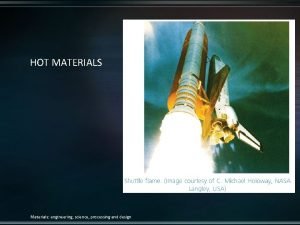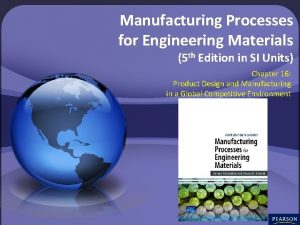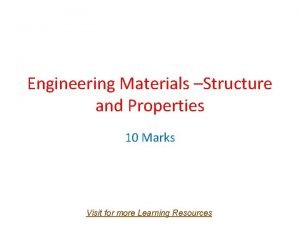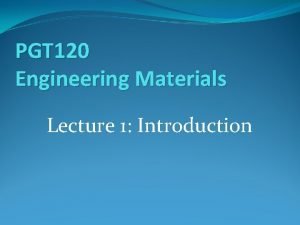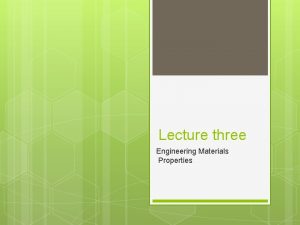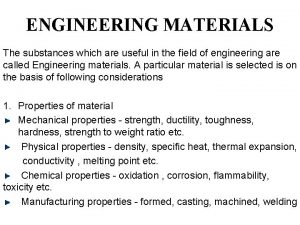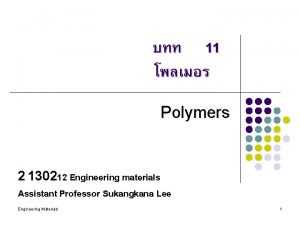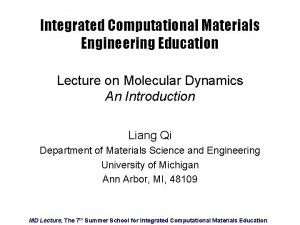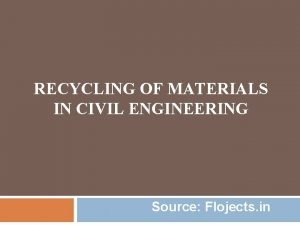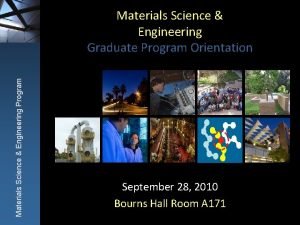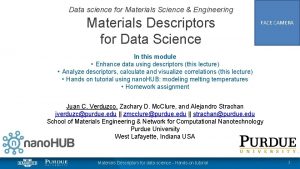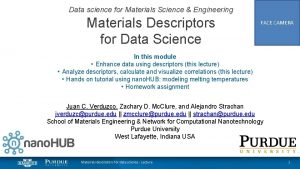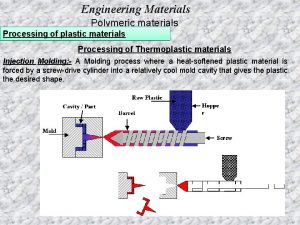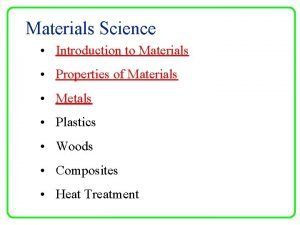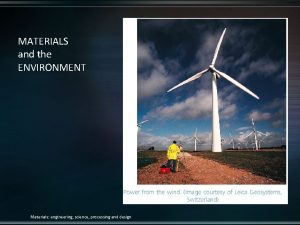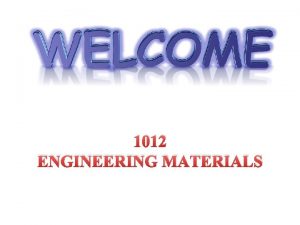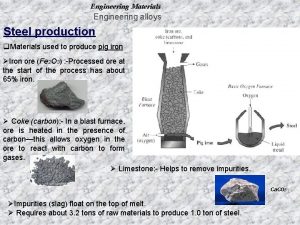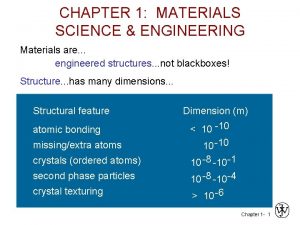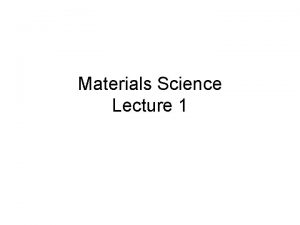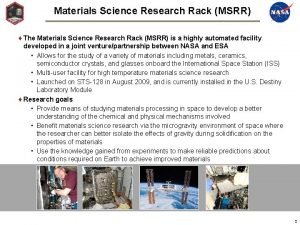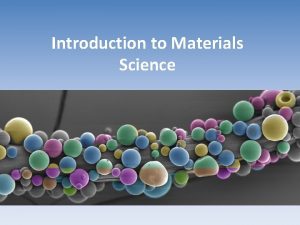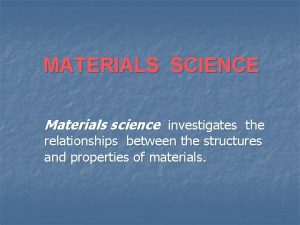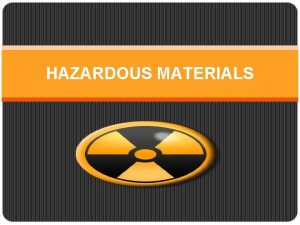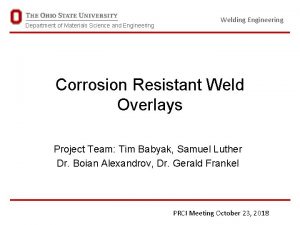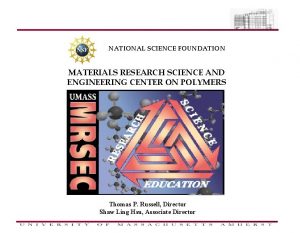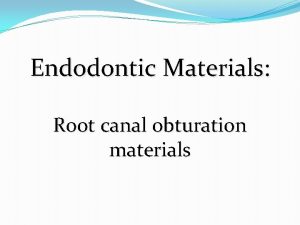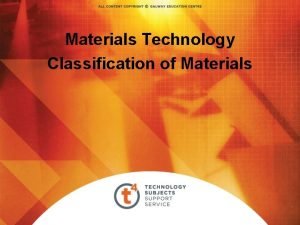The Science and Engineering of Materials 4 th




























































- Slides: 60

The Science and Engineering of Materials, 4 th ed Donald R. Askeland – Pradeep P. Phulé Chapter 9 – Solid Solutions and Phase Equilibrium 1 1

Objectives of Chapter 9 o o o The goal of this chapter is to describe the underlying physical concepts related to the structure of matter. To examine the relationships between structure of atoms-bonds-properties of engineering materials. Learn about different levels of structure i. e. atomic structure, nanostructure, microstructure, and macrostructure. 2 2

Chapter Outline o o o o 9. 1 9. 2 9. 3 9. 4 9. 5 9. 6 Phases and the Phase Diagram Solubility and Solid Solutions Conditions for Unlimited Solid Solubility Solid-Solution Strengthening Isomorphous Phase Diagrams Relationship Between Properties and the Phase Diagram 9. 7 Solidification of a Solid-Solution Alloy 9. 8 Nonequilibrium Solidification and Segregation 3 3

Section 9. 1 Phases and the Phase Diagram o o o Phase - Any portion including the whole of a system, which is physically homogeneous within it and bounded by a surface so that it is mechanically separable from any other portions. Gibbs phase rule - Describes the number of degrees of freedom, or the number of variables that must be fixed to specify the temperature and composition of a phase (2 + C = F + P, where pressure and temperature can change, 1 + C = F + P, where pressure or temperature is constant). P-T diagram - A diagram describing thermodynamic stability of phases under different temperature and pressure conditions (same as a unary phase diagram). 4 4

© 2003 Brooks/Cole, a division of Thomson Learning, Inc. Thomson Learning™ is a trademark used herein under license. Figure 9. 1 Illustration of phases and solubility: (a) The three forms of water – gas, liquid, and solid – are each a phase. (b) Water and alcohol have unlimited solubility. (c) Salt and water have limited solubility. (d) Oil and water have virtually no solubility. 5 5

© 2003 Brooks/Cole, a division of Thomson Learning, Inc. Thomson Learning™ is a trademark used herein under license. Figure 9. 2 Schematic unary phase diagram for magnesium, showing the melting and boiling temperatures at one atmosphere pressure. 6 6

Example 9. 1 Design of an Aerospace Component Because magnesium (Mg) is a low-density material (ρMg = 1. 738 g/cm 3), it has been suggested for use in an aerospace vehicle intended to enter the outer space environment. Is this a good design? Example 9. 1 SOLUTION - In space the pressure is very low. Even at relatively low temperatures, solid magnesium can begin to change to a vapor, causing metal loss that could damage a space vehicle. - A low-density material with a higher boiling point (and, therefore, lower vapor pressure at any given temperature) might be a better choice. - Other factors to consider: In load-bearing applications, we should not only look for density but also for relative strength. Therefore, the ratio of Young’s modulus to density or yield strength to density could be a better parameter to compare different materials. 7 7

Example 9. 2 Freeze Drying Synthesis of Ceramic Superconductors Many ceramic materials are made into powders using different oxides and carbonates (Chapter 14). This is because ceramics melt at too high a temperature and tend to exhibit brittle behavior. For example, the synthesis process for YBa 2 Cu 3 O 7 -x, a ceramic superconductor known as YBCO, involves mixing and reacting powders of yttrium oxide (Y 2 O 3), copper oxide (Cu. O), and barium carbonate (Ba. CO 3). The barium carbonate decomposes to Ba. O during the high temperature reactions and reacts with yttria and copper oxide to form different phases. Often, this process, known as the ‘‘oxide mix’’ technique, produces ceramic powders that are relatively coarse. Some other undesired phases may also form, and deleterious impurities (from processing or raw materials) may become incorporated in the product. 8 8

Example 9. 2 (Continued) On the other hand, chemical techniques that make use of high-purity chemicals may offer a better product (most likely at a higher cost). One such chemical process, used in the food industry (e. g. , coffee, spices, etc. ) is freeze drying. [3] For example, freeze-dried coffee is made by extracting coffee from beans and then evaporating the water from the coffee using freeze drying. An engineer decides to use water-based solutions to develop a freeze-drying synthesis of a YBCO superconductor. Using the unary phase diagram for water [Figure 9. 3(a)], explain the different steps that could be followed to generate high-purity and chemically homogeneous powders of the YBCO superconductor. 9 9

© 2003 Brooks/Cole, a division of Thomson Learning, Inc. Thomson Learning™ is a trademark used herein under license. Figure 9. 3 (a) Pressuretemperature diagram for H 2 O. The triple point temperature is 273. 0098 K and the triple point pressure is 4. 6 torr. Notice the solid-liquid line sloping to the left. At normal pressure (1 atm or 760 torr), the melting temperature is 273 K. A possible scheme for freeze drying is shown as starting with point S and following the dashed line to the left. (b) Pressure-temperature diagram for CO 2. Many researchers are examining the applications of super-critical CO 2 for use as a solvent for applications related to the processing of plastics and pharmaceuticals. (c) Pressuretemperature diagram for Si 02, The dotted line shows the 1 atm pressure. 10 10

Example 9. 2 SOLUTION - Prepare a solution of nitrates of yttrium, copper, and barium in proper cation stoichiometry. - Remove the nitric acid (HNO 3) and H 2 O without causing any melting by lowering the pressure to approximately 10 -2 torr (point B). - Increase the temperature while maintaining the low pressure causing the ice and nitric acid to sublimate (solid vapor). - The mixed metal nitrate powder will then be heated carefully and the nitrates can be decomposed to form a ceramic powder. 11 11

Section 9. 2 Solubility and Solid Solutions o o Solubility - The amount of one material that will completely dissolve in a second material without creating a second phase. Unlimited solubility - When the amount of one material that will dissolve in a second material without creating a second phase is unlimited. Limited solubility - When only a maximum amount of a solute material can be dissolved in a solvent material. Copolymer - A polymer that is formed by combining two or more different types of monomers usually with the idea of blending the properties affiliated with individual polymers, example Dylark. TM a copolymer of maleic anhydride and styrene. 12 12

© 2003 Brooks/Cole, a division of Thomson Learning, Inc. Thomson Learning™ is a trademark used herein under license. Figure 9. 4 (a) Liquid copper and liquid nickel are completely soluble in each other. (b) Solid copper-nickel alloys display complete solid solubility, with copper and nickel atoms occupying random lattice sites. (c) In copper-zinc alloys containing more than 30% Zn, a second phase forms because of the limited solubility of zinc in copper. 13 13

© 2003 Brooks/Cole, a division of Thomson Learning, Inc. Thomson Learning™ is a trademark used herein under license. Figure 9. 5 The solubility of zinc in copper. The solid line represents the solubility limit; when excess zinc is added, the solubility limit is exceeded and two phases coexist. 14 14

Figure 9. 6 Diagram showing how the properties of copolymers formed in the ABS system vary. This is not a phase diagram. (Source: From Plastics, Materials and Processing, Second Edition, by B. A. Strong, p. 223, Fig. 614. Copyright © 2000 Prentice Hall. Reprinted by permission of Pearson Education. ) 15 15

Section 9. 3 Conditions for Unlimited Solid Solubility o o Hume-Rothery rules - The conditions that an alloy or ceramic system must meet if the system is to display unlimited solid solubility. Hume-Rothery’s rules are necessary but are not sufficient for materials to show unlimited solid solubility. Hume-Rothery rules: - Size factor - Crystal structure - Valence - Electronegativity 16 16

© 2003 Brooks/Cole, a division of Thomson Learning, Inc. Thomson Learning™ is a trademark used herein under license. Figure 9. 7 Mg 0 and Ni 0 have similar crystal structures, ionic radii, and valences; thus the two ceramic materials can form solid solutions. 17 17

Example 9. 3 Ceramic Solid Solutions of Mg. O Ni. O can be added to Mg. O to produce a solid solution. What other ceramic systems are likely to exhibit 100% solid solubility with Mg. O? Example 9. 3 SOLUTION From Appendix B, some other possibilities in which the cation has a valence of +2 include the following: 18 18

Example 9. 3 SOLUTION (Continued) The percent difference in ionic radii and the crystal structures are also shown and suggest that the Fe. O-Mg. O system will probably display unlimited solid solubility. The Co. O and Zn. O systems also have appropriate radius ratios and crystal structures. 19 19

Section 9. 4 Solid-Solution Strengthening o o Solid-solution strengthening - Increasing the strength of a metallic material via the formation of a solid solution. Dispersion strengthening - Strengthening, typically used in metallic materials, by the formation of ultra-fine dispersions of a second phase. 20 20

© 2003 Brooks/Cole, a division of Thomson Learning, Inc. Thomson Learning™ is a trademark used herein under license. Figure 9. 8 The effects of several alloying elements on the yield strength of copper. Nickel and zinc atoms are about the same size as copper atoms, but beryllium and tin atoms are much different from copper atoms. Increasing both atomic size difference and amount of alloying element increases solidsolution strengthening. 21 21

Example 9. 4 -Solution Strengthening Solid From the atomic radii, show whether the size difference between copper atoms and alloying atoms accurately predicts the amount of strengthening found in Figure 9. 8. © 2003 Brooks/Cole, a division of Thomson Learning, Inc. Thomson Learning™ is a trademark used herein under license. Figure 9. 8 The effects of several alloying elements on the yield strength of copper. Nickel and zinc atoms are about the same size as copper atoms, but beryllium and tin atoms are much different from copper atoms. Increasing both atomic size difference and amount of alloying element increases solid-solution strengthening. 22 22

Example 9. 4 SOLUTION The atomic radii and percent size difference are shown below: For atoms larger than copper—namely, zinc, aluminum, and tin— increasing the size difference increases the strengthening effect. Likewise for smaller atoms, increasing the size difference increases strengthening. 23 23

© 2003 Brooks/Cole, a division of Thomson Learning, Inc. Thomson Learning™ is a trademark used herein under license. Figure 9. 9 The effect of additions of zinc to copper on the properties of the solid-solution-strengthened alloy. The increase in % elongation with increasing zinc content is not typical of solid-solution strengthening. 24 24

Section 9. 5 Isomorphous Phase Diagrams o o o Binary phase diagram - A phase diagram for a system with two components. Ternary phase diagram - A phase diagram for a system with three components. Isomorphous phase diagram - A phase diagram in which components display unlimited solid solubility. Liquidus temperature - The temperature at which the first solid begins to form during solidification. Solidus temperature - The temperature below which all liquid has completely solidified. 25 25

Figure 9. 10 (a) The equilibrium phase diagrams for the Cu. Ni and Ni. O-Mg. O systems. (b) The liquidus and solidus temperatures are shown for a Cu-40% Ni alloy. (c) and (d) Systems with solid solution maxima and minima. (Source: Adapted from Introduction to Phase Equilibria, by C. G. Bergeron, and S. H. Risbud. Copyright © 1984 American Ceramic Society. Adapted by permission. ) 26 26

Example 9. 5 -Mg. O Isomorphous System Ni. O From the phase diagram for the Ni. O-Mg. O binary system [Figure 9. 10(b)], describe a composition that can melt at 2600 o. C but will not melt when placed into service at 2300 o. C. Figure 9. 10 (b) The liquidus and solidus temperatures are shown for a Cu-40% Ni alloy. 27 27

Example 9. 5 SOLUTION To identify a composition with a liquidus temperature below 2600 o. C, there must be less than 65 mol% Mg. O in the refractory. To identify a composition with solidus temperature above 2300 o. C, there must be at least 50 mol% Mg. O present. Consequently, we can use any composition between 50 mol% Mg. O and 65 mol% Mg. O. 28 28

Example 9. 6 Design of a Composite Material One method to improve the fracture toughness of a ceramic material (Chapter 6) is to reinforce the ceramic matrix with ceramic fibers. A materials designer has suggested that Al 2 O 3 could be reinforced with 25% Cr 2 O 3 fibers, which would interfere with the propagation of any cracks in the alumina. The resulting composite is expected to operate under load at 2000 o. C for several months. Criticize the appropriateness of this design. 29 29

© 2003 Brooks/Cole, a division of Thomson Learning, Inc. Thomson Learning™ is a trademark used herein under license. Figure 9. 11 The Al 203 -Cr 203 phase diagram (for Example 9. 6). 30 30

Example 9. 6 SOLUTION Since the composite will operate at high temperatures for a substantial period of time, the two phases—the Cr 2 O 3 fibers and the Al 2 O 3 matrix—must not react with one another. In addition, the composite must remain solid to at least 2000 o. C. The phase diagram in Figure 9. 11 permits us to consider this choice for a composite. Pure Cr 2 O 3, pure Al 2 O 3, and Al 2 O 3 -25% Cr 2 O 3 have solidus temperatures above 20000 C; consequently, there is no danger of melting any of the constituents. However, Cr 2 O 3 and Al 2 O 3 display unlimited solid solubility. At the high service temperature, 2000 o. C, Al 3+ ions will diffuse from the matrix into the fiber, replacing Cr 3+ ions in the fibers. Simultaneously, Cr 3+ ions will replace Al 3+ ions in the matrix. Long before several months have elapsed, these diffusion processes cause the fibers to completely dissolve into the matrix. With no fibers remaining, the fracture toughness will again be poor. 31 31

Example 9. 7 Gibbs Rule for Isomorphous Phase Diagram Determine the degrees of freedom in a Cu-40% Ni alloy at (a) 1300 o. C, (b) 1250 o. C, and (c) 1200 o. C. Example 9. 7 SOLUTION This is a binary system (C = 2). Two components are Cu and Ni. We will assume constant pressure. Therefore, Equation 9 -2 (1 + C = F + P) can be used as follows: (a) At 1300 o. C, P = 1, since only one phase (liquid) is present; C = 2, since both copper and nickel atoms are present. Thus: 1 + C = F + P So, 1 + 2 = F + 1 or F = 2 32 32

Example 9. 7 SOLUTION (Continued) (b) At 1250 o. C, P = 2, since both liquid and solid are present; C = 2, since copper and nickel atoms are present. Now: 1 + C = F + P So, 1 + 2 = F + 2 or F = 1 (c) At 1200 o. C, P = 1, since only one phase, solid, is present; C = 2, since both copper and nickel atoms are present. Again, 1 + C = F + P So, 1 + 2 = F + 1 or F = 2 33 33

© 2003 Brooks/Cole, a division of Thomson Learning, Inc. Thomson Learning™ is a trademark used herein under license. Figure 9. 12 A hypothetical binary phase diagram between elements A and B. When an alloy is present in a twophase region, a tie line at the temperature of interest fixes the composition of the two phases. This is a consequence of the Gibbs phase rule, which provides only one degree of freedom. 34 34

Example 9. 8 Compositions of Phases in Cu-Ni Phase Diagram © 2003 Brooks/Cole, a division of Thomson Learning, Inc. Thomson Learning™ is a trademark used herein under license. Determine the composition of each phase in a Cu-40% Ni alloy at 1300 o. C, 1270 o. C, 1250 o. C, and 1200 o. C. (See Figure 9. 13. ) Figure 9. 13 Tie lines and phase compositions for a Cu-40% Ni alloy at several temperatures (for Example 9. 8). 35 35

Example 9. 8 SOLUTION The vertical line at 40% Ni represents the overall composition of the alloy: - 1300 o. C: Only liquid is present. The liquid must contain 40% Ni, the overall composition of the alloy. - 1270 o. C: Two phases are present. The liquid contains 37% Ni and the solid contains 50% Ni. - 1250 o. C: Again two phases are present. The tie line drawn at this temperature shows that the liquid contains 32% Ni and the solid contains 45% Ni. - 1200 o. C: Only solid contain 40% Ni. is present, so the solid must 36 36

Example 9. 9 Application of Lever Rule Calculate the amounts of and L at 1250 o. C in the Cu-40% Ni alloy shown in Figure 9. 14 A tie line 1250°C in the copper-nickel system that is used in Example 9. 9 to find the amount of each phase. © 2003 Brooks/Cole, a division of Thomson Learning, Inc. Thomson Learning™ is a trademark used herein under license. 37 37

Example 9. 9 SOLUTION Let’s say that x = mass fraction of the alloy that is solid. Since we have only two phases, the balance of nickel must be in the liquid phase (L). Thus, the mass fraction of nickel in liquid will be 1 - x. Total mass of nickel in 100 grams of the alloy = mass of nickel in liquid + mass of nickel in So, 100 (% Ni in alloy = [(100)(1 – x)](% Ni in L) + (100)[x](% Ni in ) x = (40 -32)/(45 -32) = 8/13 = 0. 62 If we convert from mass fraction to mass percent, the alloy at 1250 o. C contains 62% a and 38% L. Note that the concentration of Ni in alpha phase (at 1250 o. C) is 45% and concentration of nickel in liquid phase (at 1250 o. C) is 32%. 38 38

Example 9. 10 Solidification of a Cu-40% Ni Alloy © 2003 Brooks/Cole, a division of Thomson Learning, Inc. Thomson Learning™ is a trademark used herein under license. Determine the amount of each phase in the Cu-40% Ni alloy shown in Figure 9. 13 at 1300 o. C, 1270 o. C, 1250 o. C, and 1200 o. C. Figure 9. 13 Tie lines and phase compositions for a Cu -40% Ni alloy at several temperatures 39 39

Example 9. 10 SOLUTION 40 40

Section 9. 6 Relationship Between Properties and the Phase Diagram 41 41

© 2003 Brooks/Cole, a division of Thomson Learning, Inc. Thomson Learning™ is a trademark used herein under license. Figure 9. 15 The mechanical properties of copper-nickel alloys. Copper is strengthened by up to 60% Ni and nickel is strengthened by up to 40% Cu. 42 42

Example 9. 11 Design of a Melting Procedure for a Casting © 2003 Brooks/Cole, a division of Thomson Learning, Inc. Thomson Learning™ is a trademark used herein under license. You need to produce a Cu-Ni alloy having minimum yield strength of 20, 000 psi, a minimum tensile strength of 60, 000 psi, and a minimum % elongation of 20%. You have in your inventory a Cu 20% Ni alloy and pure nickel. Design a method for producing castings having the required properties. Figure 9. 15 The mechanical properties of copper-nickel alloys. Copper is strengthened by up to 60% Ni and nickel is strengthened by up to 40% Cu. 43 43

Example 9. 11 SOLUTION From Figure 9. 15, we determine the required composition of the alloy. To satisfy all of these conditions, we could use: Cu-90% Ni or Cu-33% to 60% Ni We prefer to select a low nickel content, since nickel is more expensive than copper. In addition, the lower nickel alloys have a lower liquidus, permitting castings to be made with less energy being expended. Therefore, a reasonable alloy might be Cu-35% Ni. 44 44

Example 9. 11 SOLUTION (Continued) To produce this composition from the available melting stock, we must blend some of the pure nickel with the Cu-20% Ni ingot. Assume we wish to produce 10 kg of the alloy. Let x be the mass of Cu-20% Ni alloy we will need. The mass of pure Ni needed will be 10 - x. Since the final alloy consists of 35% Ni, the total mass of Ni needed will be: (10 Kg)( 35% Ni / 100%) = 3. 5 Kg Ni Now let’s write a mass balance for nickel. Nickel from the Cu-20% alloy + pure nickel added = total nickel in the 35% alloy being produced. 0. 2 x + 10 - x = 3. 5 6. 5 = 0. 8 x x = 8. 125 kg 45 45

Section 9. 7 Solidification of a Solid-Solution Alloy o Segregation - The presence of composition differences in a material, often caused by insufficient time for diffusion during solidification. 46 46

© 2003 Brooks/Cole, a division of Thomson Learning, Inc. Thomson Learning™ is a trademark used herein under license. Figure 9. 16 The change in structure of a Cu 40% Ni alloy during equilibrium solidification. The nickel and copper atoms must diffuse during cooling in order to satisfy the phase program and produce a uniform equilibrium structure. 47 47

© 2003 Brooks/Cole, a division of Thomson Learning, Inc. Thomson Learning™ is a trademark used herein under license. Figure 9. 17 The cooling curve for an isomorphous alloy during solidification. We assume that cooling rates are small so as to allow thermal equilibrium to take place. The changes in slope of the cooling curve indicate the liquidus and solidus temperatures, in this case for a Cu-40% Ni alloy. 48 48

Section 9. 8 Nonequilibrium Solidification and Segregation o o Coring - Chemical segregation in cast products, also known as microsegregation or interdendritic segregation. Homogenization heat treatment - The heat treatment used to reduce the microsegregation caused during nonequilibrium solidification. Macrosegregation - The presence of composition differences in a material over large distances caused by nonequilibrium solidification. Spray atomization - A process in which molten alloys or metals are sprayed using a ceramic nozzle. 49 49

© 2003 Brooks/Cole, a division of Thomson Learning, Inc. Thomson Learning™ is a trademark used herein under license. Figure 9. 18 The change in structure of a Cu 40% Ni alloy during nonequilibrium solidification. Insufficient time for diffusion in the solid produces a segregated structure. 50 50

Example 9. 12 Nonequilibrium Solidification of Cu-Ni Alloys Calculate the composition and amount of each phase in a Cu-40% Ni alloy that is present under the nonequilibrium conditions shown in Figure 9. 18 at 1300 o. C, 1280 o. C, 1260 o. C, 1240 o. C, 1200 o. C, and 1150 o. C. Compare with the equilibrium compositions and amounts of each phase. 51 51

© 2003 Brooks/Cole, a division of Thomson Learning, Inc. Thomson Learning™ is a trademark used herein under license. Figure 9. 18 The change in structure of a Cu 40% Ni alloy during nonequilibrium solidification. Insufficient time for diffusion in the solid produces a segregated structure. 52 52

Example 9. 12 SOLUTION We use the tie line upto the equilibrium solidus temperature to calculate composition and percentages of phases as per the lever rule. Similarly, the nonequilibrium solidus temperature curve is used to calculate percentages and concentrations of different phases formed under nonequilibrium conditions. 53 53

Example 9. 12 SOLUTION (Continued) 54 54

Figure 9. 19 (a) Microsegregation between dendrites can be reduced by a homogenization heat treatment. Counterdiffusion of nickel and copper atoms may eventually eliminate the composition gradients and produce a homogeneous composition. (b) Spray atomized powders of superalloys. (c) Progression of densification in low carbon Astroalloy sample processed using HIP. (Courtesy of J. Staite, Hann, B. and Rizzo, F. , Crucible Compaction Metals. ) 55 55

© 2003 Brooks/Cole, a division of Thomson Learning, Inc. Thomson Learning™ is a trademark used herein under license. Figure 9. 21 The equilibrium phase diagram for the Mg 0 -Fe 0 system. 56 56

© 2003 Brooks/Cole, a division of Thomson Learning, Inc. Thomson Learning™ is a trademark used herein under license. Figure 9. 22 The equilibrium phase diagram for the Nb -W system. 57 57

© 2003 Brooks/Cole, a division of Thomson Learning, Inc. Thomson Learning™ is a trademark used herein under license. Figure 9. 23 Cooling curve for a Ni 0 -Mg 0 ceramic (for Problem 9. 66). 58 58

© 2003 Brooks/Cole, a division of Thomson Learning, Inc. Thomson Learning™ is a trademark used herein under license. Figure 9. 24 Cooling curve for a Nb-W alloy (for Problem 9. 68). 59 59

© 2003 Brooks/Cole, a division of Thomson Learning, Inc. Thomson Learning™ is a trademark used herein under license. Figure 9. 25 Cooling curves for a series of Mo-V alloys (for Problem 9. 69). 60 60
 Materials: engineering, science, processing and design
Materials: engineering, science, processing and design Eacademics iitd ac in sportal login
Eacademics iitd ac in sportal login What is her favourite subject
What is her favourite subject Cant stop the feeling go noodle
Cant stop the feeling go noodle Household materials useful harmful
Household materials useful harmful Natural man made
Natural man made Adopting materials
Adopting materials Direct materials budget with multiple materials
Direct materials budget with multiple materials Processed materials grade 5
Processed materials grade 5 Metals and non metals grade 5
Metals and non metals grade 5 Matter and materials grade 6
Matter and materials grade 6 Manufacturing processes for engineering materials 5th
Manufacturing processes for engineering materials 5th Types of engineering materials
Types of engineering materials What is the engineering materials
What is the engineering materials Optical properties of engineering materials
Optical properties of engineering materials Properties of engineering materials
Properties of engineering materials Engineering materials
Engineering materials Materials for engineering
Materials for engineering Integrated computational materials engineering
Integrated computational materials engineering Integrated computational materials engineering
Integrated computational materials engineering Civil engineering source
Civil engineering source Forward engineering and reverse engineering
Forward engineering and reverse engineering Hình ảnh bộ gõ cơ thể búng tay
Hình ảnh bộ gõ cơ thể búng tay Slidetodoc
Slidetodoc Bổ thể
Bổ thể Tỉ lệ cơ thể trẻ em
Tỉ lệ cơ thể trẻ em Voi kéo gỗ như thế nào
Voi kéo gỗ như thế nào Thang điểm glasgow
Thang điểm glasgow Chúa yêu trần thế
Chúa yêu trần thế Môn thể thao bắt đầu bằng từ đua
Môn thể thao bắt đầu bằng từ đua Thế nào là hệ số cao nhất
Thế nào là hệ số cao nhất Các châu lục và đại dương trên thế giới
Các châu lục và đại dương trên thế giới Cong thức tính động năng
Cong thức tính động năng Trời xanh đây là của chúng ta thể thơ
Trời xanh đây là của chúng ta thể thơ Mật thư anh em như thể tay chân
Mật thư anh em như thể tay chân Làm thế nào để 102-1=99
Làm thế nào để 102-1=99 độ dài liên kết
độ dài liên kết Các châu lục và đại dương trên thế giới
Các châu lục và đại dương trên thế giới Thơ thất ngôn tứ tuyệt đường luật
Thơ thất ngôn tứ tuyệt đường luật Quá trình desamine hóa có thể tạo ra
Quá trình desamine hóa có thể tạo ra Một số thể thơ truyền thống
Một số thể thơ truyền thống Cái miệng nó xinh thế
Cái miệng nó xinh thế Vẽ hình chiếu vuông góc của vật thể sau
Vẽ hình chiếu vuông góc của vật thể sau Nguyên nhân của sự mỏi cơ sinh 8
Nguyên nhân của sự mỏi cơ sinh 8 đặc điểm cơ thể của người tối cổ
đặc điểm cơ thể của người tối cổ V cc
V cc Vẽ hình chiếu đứng bằng cạnh của vật thể
Vẽ hình chiếu đứng bằng cạnh của vật thể Vẽ hình chiếu vuông góc của vật thể sau
Vẽ hình chiếu vuông góc của vật thể sau Thẻ vin
Thẻ vin đại từ thay thế
đại từ thay thế điện thế nghỉ
điện thế nghỉ Tư thế ngồi viết
Tư thế ngồi viết Diễn thế sinh thái là
Diễn thế sinh thái là Dạng đột biến một nhiễm là
Dạng đột biến một nhiễm là Bảng số nguyên tố
Bảng số nguyên tố Tư thế ngồi viết
Tư thế ngồi viết Lời thề hippocrates
Lời thề hippocrates Thiếu nhi thế giới liên hoan
Thiếu nhi thế giới liên hoan ưu thế lai là gì
ưu thế lai là gì Sự nuôi và dạy con của hổ
Sự nuôi và dạy con của hổ Sự nuôi và dạy con của hổ
Sự nuôi và dạy con của hổ
